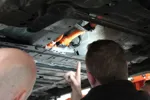Baur says: “We must always consider efficiency, but designers will always try to create a smoother look dependent on the proportions of the type of car being styled. An SUV sits higher than a coupé, but both have to work on a design and engineering level.”
Designing cars for safety
Renault has sidestepped these considerations to some extent with its new Twingo, which has a rear-mounted engine. It could well be a sign of things to come in the small car sector. By moving the engine to the rear, pedestrian safety is much easier to design and manage as there is no solid lump of engine to account for in a frontal collision.
There are other challenges in designing a small car. Customers want as much interior space as possible and there is an ever-increasing demand for a premium feel as many drivers downsize.
Melville says: “Miniaturisation of components such as airbags and the hardware fitted behind the dashboard is an important direction for engineering that impacts directly on the design. With smaller components, we can move the dash further away from the occupants to create more space and make the car safer.”
As for the premium feel of cars, this is another theme echoed by the designers we spoke to. European customers expect new cars to look and feel a cut above what is perceived to be the average. This is proving particularly important in small cars, where the likes of the Mini and Fiat 500 have led the way.
Incorporating a more premium feel is partly down to the materials used, such as the steering wheel, dash controls and door handles. However, Ward says it is also to do with the appearance of a car: “A dynamic-looking car will usually have windscreen pillars that slope forward at quite a steep angle, but this can compromise driver vision and pedestrian safety.
“Will we witness see-through front pillars? I don’t think so, but I think we will see innovative positioning and clever ways of masking where they sit. I also think we’ll see more advanced use of glass to curve around corners.”













Login to comment
Comments
No comments have been made yet.